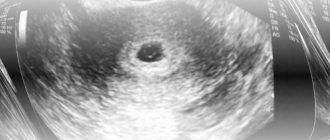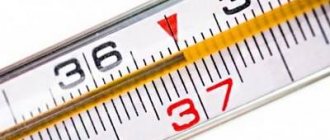Hello, my dear readers! Today I am talking about those first exciting minutes when a woman becomes convinced that she will soon be called a mother. Usually such confidence comes after the test shows two stripes. The next question that begins to worry a pregnant woman is when to expect the birth of a small miracle. There are many methods, both purely medical and folk, tested by our grandmothers. Now we will talk about how doctors determine the duration of pregnancy.
Why do you need to know your gestational age?
If we talk about methods for determining the duration of pregnancy, some can be called not very accurate, but convenient and accessible to most women, while others, more accurate, require special diagnostic examinations.
All these methods for determining the period serve one purpose - competent monitoring of the course of pregnancy and fetal development. Knowing the exact number of weeks of pregnancy makes it possible to timely diagnose developmental pathologies of the unborn child (for example, Down syndrome), deviations from the norm, and accurately determine the date of future birth. When the doctor knows the gestational age, then using ultrasound it is possible to compare generally accepted indicators and characteristics of fetal development with a specific pregnancy. So, let's look at ways to determine the duration of pregnancy with their advantages and disadvantages.
How to determine the gestational age by the date of conception?
Conceiving a child is the fusion of an egg and a sperm, which occurs within a day or two after ovulation. Some ladies feel it based on certain symptoms, others purchase special tests to identify it, and still others measure their basal temperature for this purpose. Therefore, it is easiest for the category of women who feel the onset of ovulation and know the day of conception to independently determine the duration of pregnancy.
But even if you accurately calculate the day of conception (if sexual intercourse was only once), gynecologists, for a number of reasons, put the gestational age at 2 weeks longer. Pregnant women consider this a sign of carrying a large child. Unfortunately, in the first weeks the size of the embryos is almost the same. Doctors simply state the gestational age. It is used to calculate the date of future birth. Therefore, knowing your gestational age by the day of conception is interesting for the pregnant woman herself, and not for her doctor.
By the way, some expectant mothers keep their due date calendar until the end of pregnancy. Then it will be simply interesting to compare it and the doctor’s term, to determine whose was more accurate.
How to calculate the gestational age from the first movement?
The first movement of the unborn child is an important parameter in the course of pregnancy. After all, doctors, as a rule, record the future due date depending on the ultrasound readings in the first trimester and the day the baby first moves. Women giving birth for the first time feel such movements at the twentieth week of pregnancy, and multiparous women a little earlier - at 18 weeks.
Online pregnancy calendar by week
For those wishing to make a pregnancy calculation, you must indicate on the calendar provided the date of the first day of your last menstruation . After this, the calculator will calculate the date of conception and birth.
- Start of menstruation
The first day of your period that you specified. - 1
The first 7 days can be characterized by pain, since it is associated with the beginning of the monthly cycle. It is still impossible to predict whether pregnancy will occur or not, since fertilization of the egg has not yet occurred. - 2
There are still no special signs of a special situation; there is only a slight heaviness in the lower abdomen. It is too early to talk about the fetus, since it exists only in the form of an egg placed in a follicle. - Conception
Day of conception. Obstetricians and gynecologists are inclined to believe that conception occurs in the 2nd week of pregnancy. - 3
The woman begins to notice the first signs of her situation: excessive fatigue, drowsiness, frequent urge to urinate, high sensitivity to odors. - 4
The first health difficulties begin. The following symptoms appear: breast swelling, increased sensitivity, touching causes pain, mood changes sharply, and it is difficult to control oneself. - 5
The respiratory and cardiovascular systems develop, muscle mass and internal organs grow. The embryo increases in size, which is why the emotional state can change dramatically, severe headaches, nausea appear, drowsiness increases, strength is lost, and you constantly want to go to the toilet. - 6
Usually during this period everyone learns about their situation. The baby’s nervous system is strengthened, tightened with tissue, and the brain is located at the end of the tube. The child's eyes are developing, but they are still fragile and small. The heart begins to function. - 7
The baby is acquiring facial features; you can see small eyes, a nose and a mouth if you undergo an ultrasound scan. The gastrointestinal tract actively develops, the large and small intestines appear. The brain grows and develops, an umbilical cord is formed, which is connected to the wall of the uterus. - 8
The nervous system and brain were finally formed. The fetus begins to make its first movements. - 9
The height of the fetus reaches 23-30 mm, and its weight is 2 grams. The embryo has almost straightened up, and very soon its tail will disappear. - 10
The embryonic stage of development ends. Starting next week, he will be considered a fetus, not an embryo. The woman’s feelings do not change, her poor health remains, because the hormones are still growing. - 11
The baby's weight is already 7-8 grams, and the length from the tailbone to the crown is 5 centimeters. Now the fetus will grow faster, despite the fact that its development and organs are still growing. - 12
The genitals have already formed, so an ultrasound can show who has “settled” with you - a girl or a boy. - 13
The woman has ended the “discomfortable” stage: her emotional background has improved, smells and food have ceased to irritate her, tearfulness is no longer observed, but another problem arises - difficulties with assimilation of food. Nowadays I often suffer from constipation, as the uterus is getting larger and larger, and the hormonal levels are significantly changed. - 14
The fetus is active, makes many different movements, and may frown and clench its fists. Now the child’s height reaches 90 mm, and his weight is 35 grams. - 15
The formation of the cerebral cortex has begun, which will continue over the next month. - 16
The expectant mother feels great: she has a lot of strength, energy, she is calm and peaceful, and she is no longer bothered by sudden mood swings. A good appetite awakens. - 17
Now the child’s CTE is, as a rule, 13 cm, and his weight reaches 140 grams. The fruit is already quite large, and its size reaches an open palm. - 18
The uterus is continuously growing and becoming even taller. The expectant mother begins to experience discomfort while sleeping and tries to find a comfortable position in which she would be comfortable. You can buy a special pillow, sleep on your back, and relax before bed. - 19
Every slightest movement is felt. He moves very often, which brings a lot of discomfort. The expectant mother's body weight increases, and her hips become wider. Changes occur in the gait, as the stomach pulls down and posture is disturbed. - 20
The baby goes about its business in the placenta: sucking its thumb, spinning, doing somersaults, sometimes yawning and tugging at the umbilical cord. The protective skin layer continues to grow and four layers of skin are formed. - 21
Now the height is determined from the crown to the heels, and it is approximately 26.5 cm. The weight of the fetus is about 360 grams. - 22
During this period, anemia often appears - low levels of iron in the blood. This causes a lot of inconvenience, so it is advisable to visit a doctor. Pain in the legs, back and lower back may also occur. - 23
The digestive system has already completely formed and its work has been established: the stomach, esophagus, pancreas, small and large intestines. The fetus makes rhythmic breathing movements, swallowing amniotic fluid. - 24
The child's body weight reaches 550 grams. Now it is difficult for him to move freely, since he occupies most of the uterus. In panic, he hits his hands on everything he sees. Now he is as close as possible to the outside world and listens to all surrounding sounds, and also notices changes in the situation. - 25
A woman’s condition can deteriorate sharply: severe pressure appears in the diaphragm, heartburn, pain in the ribs. This is explained by the increased weight of the baby, which reaches 700 grams, as well as the height of a soccer ball. - 26
Now the body weight of the fetus is approximately 850 grams, so the mother feels its movements more and more. The woman suffers from pain in her back and ribs. To somehow smooth them out, you can buy a mattress for pregnant women. Consult a specialist before purchasing it. - 27
The brain and nervous system are rapidly developing. The small pituitary gland produces the hormone sonatropin, which promotes the rapid growth of future offspring. - 28
The child finally opened his eyes. Now he has them blue, but over time they will turn green or brown before giving birth. Hair on the head grows faster, eyelashes become expressive. - 29
Enamel appears on the teeth, but they are still hidden by the gums. The fetal immunity improves several times due to the production of leukocytes. Its body weight is about 1250 grams. - 30
Now the child already weighs 1400 grams, so it is very difficult for the expectant mother to move normally. There is strong pressure in the back muscles, they sink lower and lower, and severe pain occurs in the lower back. - 31
May cause severe pain in the lumbar region. Due to the relaxation of muscle tissue, blood vessels dilate, so it is likely that varicose veins may appear at this time. Since there is already quite a lot of amniotic fluid, and the weight of the future offspring is impressive - almost 1600 grams, the woman gains about 8 kilograms of body weight. - 32
He has finally become comfortable in his tummy and is listening to the work of his mother’s internal organs. He listens to her voice, and after birth he immediately recognizes his mother upon first contact. Wrinkles are already smoothing out, hair continues to grow. The functioning of the nervous system is improved, the child is not afraid of bright light. - 33
The child sleeps a lot, so discomfort from his spontaneous movements no longer bothers him. The baby’s brain has neural connections, he studies the environment, is interested in what is happening in the outside world. The weight of the fruit reaches 2000 grams. - 34
All vital functions of the body were activated: stomach function, heartbeat, breathing, musculoskeletal system. Contractions may appear, and their frequency increases, and the stomach stretches a little. As a rule, this is associated with spasms in the upper area of the uterus. The weight of the fetus is approximately 2250 grams. - 35
The urge to urinate becomes more frequent, making it difficult to sleep peacefully. It is necessary to choose a comfortable sleeping position, since the spine is always tense and severe pain may occur. - 36
Bone tissue is strengthened, and the baby is ready for childbirth. Its weight is 2700 grams. The expectant mother feels his every movement, especially in the chest area. - 37
Breathing is normal, food is digested well, but the urge to urinate is still frequent. This is explained by the fact that the fetal head descends into the pelvic area. Due to the rapid accumulation of adipose tissue, his body weight also increases - it reaches 3 kg. - 38
The original lubricant disappears along with the protective fuzz. The baby's large intestine is filled with dead cells that will be passed out as feces after birth. - 39
At this stage, the baby has changed his position - he pressed his knees to his chin and is ready to be born. Now he is completely immobilized, and his weight continues to grow. All organs are already functioning like an ordinary person, but he is still very weak. - 40
Contractions are often felt and pass quickly. Each spasm causes many vivid emotions, because there is fear that labor is about to begin. As a rule, many people give birth earlier than planned, for example, at 39 or 40 weeks. - 41
The hair on the head continues to grow, so if the birth occurs during this period, the baby will have very long strands. Most women worry that something is wrong, because the fetus hardly moves. However, this is quite natural, since the surrounding space does not allow him to make free movements. - 42
The placenta becomes outdated and is no longer able to fully cope with its main function - the delivery of oxygen and nutrients. This causes oxygen starvation for the child. But don't worry - there's still time. - 43
This period implies a post-term pregnancy. As a rule, the woman is admitted to a hospital and labor stimulation begins. - Childbirth
Probable day of birth (PDD)
How do doctors determine the gestational age?
When a pregnant woman comes to the antenatal clinic for the first time, the gynecologist must examine her on the chair. A gynecological examination helps in identifying existing problems and determining the duration of pregnancy. Good doctors can quite accurately determine the duration of pregnancy (with an accuracy of half a week), as well as the location of the fetus (meaning its likely location outside the uterus).
You should know that a gynecological examination of a pregnant woman with a delay of 3-4 weeks, that is, at a period of 5-6 weeks, reveals a slightly enlarged uterus. It is approximately the same size as a chicken egg. And at 8 weeks the uterus is the size of a goose egg. Approximately the size of a woman's fist, she is the size of 10 weeks pregnant. Without any problems, the gynecologist determines the size of the uterus after 12-14 weeks of pregnancy. We are talking about the length of the uterus when examining a pregnant woman on the couch. In this case, the doctor uses a measuring tape.
More on the topic
How to determine the gestational age from the last menstruation
Methods for determining gestational age and due date
How to correctly and accurately calculate the gestational age?
What is the obstetric gestational age?
Gestational age 16 weeks
Setting a deadline for hCG analysis
This is the most accurate way to determine the duration of pregnancy. It is worth noting that human chorionic gonadotropin (hCG) is a specific pregnancy hormone that is secreted in a woman’s body from the moment the fertilized egg is implanted into the endometrium of the uterus. And this happens, as we have already written, approximately 7-10 days after fertilization.
During the normal course of a singleton pregnancy, every two days the amount of hCG in the body doubles, that is, it increases in arithmetic progression. Home pregnancy tests are also based on the determination of this hormone in the urine, but it appears in the urine later and in smaller quantities than in the blood.
That is why testing for hCG using a blood test gives a quick and accurate result, and the real gestational age can be determined by the quantitative indicator of hCG in the blood.
After such testing, you will no longer have to guess when fertilization occurred, and whether there was a shift in the day of ovulation - everything will be extremely clear.
And in order to make sure that the pregnancy is normal, you can take this test again and track the dynamics of the quantitative hCG indicator.
You need to take a repeat test no earlier than 2 days after the previous one (you can take it after 4 or 6 days). Normally, after 2 days the quantitative indicator of hCG will double.
If you have taken a blood test for hCG, be sure to coordinate its results with the obstetric gestational age set by your doctor. This is important for the correct appointment of screening ultrasounds and certain tests, which should only be taken within specific periods.
How to determine the gestational age from the last menstruation?
Determining the duration of pregnancy by menstruation is called the obstetric period. How is it calculated?
This is not difficult, because the date of ovulation in this case is not taken into account. The duration of menstruation itself is not important. The doctor needs to know the date of the first day of the pregnant woman's last menstrual period. It is from this day that the doctor begins to calculate the gestational age. That is, if you went to the antenatal clinic one week after the delay and are absolutely sure that your pregnancy is 3 weeks, then the gynecologist will give you a 5 week pregnancy.
Formula for determining the maximum permissible value
Every expectant mother dreams of finding out when her baby will be born. To calculate the maximum permissible value, there are various calculations and tables that she can use independently.
Naegele's formula
This formula can be applied when a woman has menstrual periods regularly without interruptions:
- Option 1. By the day the last menstruation begins, add 7 days, and subtract another three months from the result.
- Option 2. First day of menstruation plus 9 months and a week.
To simplify the calculation, there are even special pregnancy calendars, where the calculations have already been made. All that remains is to determine the date of birth of the baby based on the day of your last menstruation.
Practice shows that children are rarely born on the exact day that falls during the calculation. But this is not the most important thing, the main thing is that he is born healthy.
How to determine the gestational age using ultrasound?
Traditionally, a woman’s first ultrasound examination is prescribed at 12-14 weeks of pregnancy. But at this estimated time it is problematic to establish its accuracy. After all, the embryos of all expectant mothers develop equally only in the first weeks after conception. Then the doctor is able to determine the period with an accuracy of one day, and clarify the position of the child in the absence of a heartbeat. And if the ultrasound shows any abnormalities, then a repeat examination is prescribed after a week or ten days to accurately determine the abnormalities and exclude a frozen pregnancy.
That is, it is possible to determine the gestational age by ultrasound only in the early stages. During the next two planned ultrasounds, doctors will set the gestational age in accordance with the parameters of the body parts of the unborn child, his head. However, we should not forget that the second half of pregnancy is a purely individual development of babies. After all, the birth at term of girls and boys weighing 2800 g and 4000 g is considered normal.
Accuracy of date of birth calculation
Today it is impossible to independently calculate the exact date of birth, because in the life of a pregnant woman any situation can occur that can provoke a longer pregnancy or premature birth.
The doctor only determines the estimated time of birth of the baby . But it is also worth remembering that the accuracy of calculating the day of birth (provided that the pregnant woman does not have any health problems) also depends on the method.
The method based on the number of conception does not allow you to accurately determine the baby’s birthday due to the fact that the exact timing of ovulation was not determined.
That is, fertilization does not occur on the day of sexual intercourse, but throughout the life of the egg (48 hours).
Calculation using Naegele's formula is more accurate , since the day of the last menstruation indicates the ovulation period.











